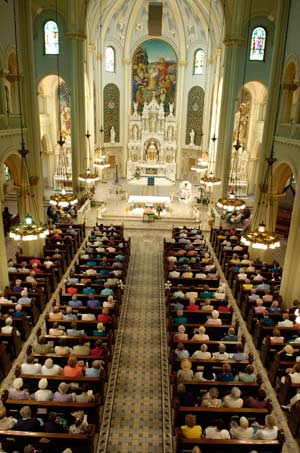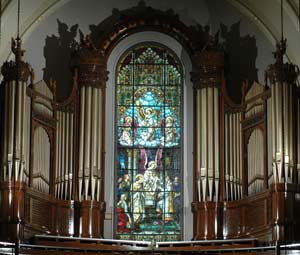MILWAUKEE — St. Joseph Chapel, an official city landmark since 1973, is a jewel hiding in plain sight on the south side of Milwaukee. The School Sisters of St. Francis have taken care of this chapel for 94  St. Joseph Chapel, consecrated in 1917, has been designated as an architectural and a historical landmark of the City of Milwaukee. Located in the motherhouse of the School Sisters of St. Francis in Milwaukee, the ceiling of the chapel is six stories high with marble imported from Italy, France, Switzerland, Germany, Greece and Mexico. (Submitted photo courtesy the School Sisters of St. Francis)years.
St. Joseph Chapel, consecrated in 1917, has been designated as an architectural and a historical landmark of the City of Milwaukee. Located in the motherhouse of the School Sisters of St. Francis in Milwaukee, the ceiling of the chapel is six stories high with marble imported from Italy, France, Switzerland, Germany, Greece and Mexico. (Submitted photo courtesy the School Sisters of St. Francis)years.
Recently, it underwent a makeover of sorts starting with maintenance in 1997 on the 115 stained glass windows all the way to replacing the slate rock roof earlier this year.
While working on the windows, administrators noticed some water damage on the interior of the chapel. Plans were made to replace the roof.
Pamela Mueller, director of mission advancement for the School Sisters of St. Francis, said the maintenance, not just on the windows and roof but the pews and a smaller roof, was paid for through a “grassroots” effort.
“What we experienced from this campaign over the years is a lot of small gifts and a handful of large bequests,” Mueller said. “But what happened was the economy shifted really quickly and we felt the timing wasn’t right with so many people struggling to make ends meet.”
Despite the financial hardships, people continued to donate what they had.
“I was extremely humbled by the generosity of our partners,” Mueller said. “People that gave them money for their birthday would walk in and say ‘This is for the roof.’”
The ceiling is six stories high with marble imported from Italy, France, Switzerland, Germany, Greece and Mexico. It seats 500 people on hand-carved pews that were newly finished in 2008.
“This was built in World War I where U-Boats were being sunk all the time and so every piece of marble, every piece of material that came over from Europe … none of it was sunk, it all arrived safely,” Mueller said.
Mueller said the sisters had a love for music and built the chapel so the songs played during Mass can easily rest on the ears of listeners. The chapel has been used for concerts and recording music.
The cost to replace the slate rock roof was nearly $2 million and the money was raised with relatively little fundraising over two years.
“The only official fundraising that we did is that we did do direct mail campaigns asking our donors for donations which is a pretty standard appeal asking for help,” Mueller said. “Instead of going out and begging people to give to this, there was just this rush of generosity.”
While funding the roof, the sisters also focused on paying for their missions in 10 countries and the wellbeing of retired sisters, and reducing spending as much as possible.
 A three-manual, 35-rank Casavant organ was installed in the chapel in 1981. (Submitted photo courtesy the School Sisters of St. Francis)“All those things that we fund, we were able to do that and put money aside to pay for the roof,” Mueller said. “Every part that we saved on the expenses, also, we applied to the roof project as well.”
A three-manual, 35-rank Casavant organ was installed in the chapel in 1981. (Submitted photo courtesy the School Sisters of St. Francis)“All those things that we fund, we were able to do that and put money aside to pay for the roof,” Mueller said. “Every part that we saved on the expenses, also, we applied to the roof project as well.”
Even the roofer, Gross Roofing Inc. in Sussex, did its part to save money.
“This is not an easy project to bid out; there’s not a lot of roofers that can do this on a historical building,” Mueller said. “Our roofer, in order to save us money, went to Vermont to the quarry where the slate was given and he negotiated right there to get us a reduced price.”
As the project of replacing the roof was underway, when the original slate was removed they discovered the roof was held together by nails and some of the wooden holes were rotten.
“You would think the magnitude and scope of that project, to just only find rotted wood after 90 some years … pretty good,” Mueller said. “We thought we were being good stewards by replacing it with slate and that should last another 100 years.”
